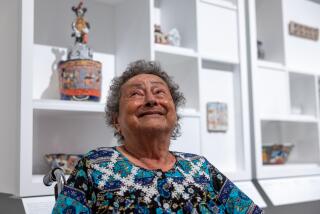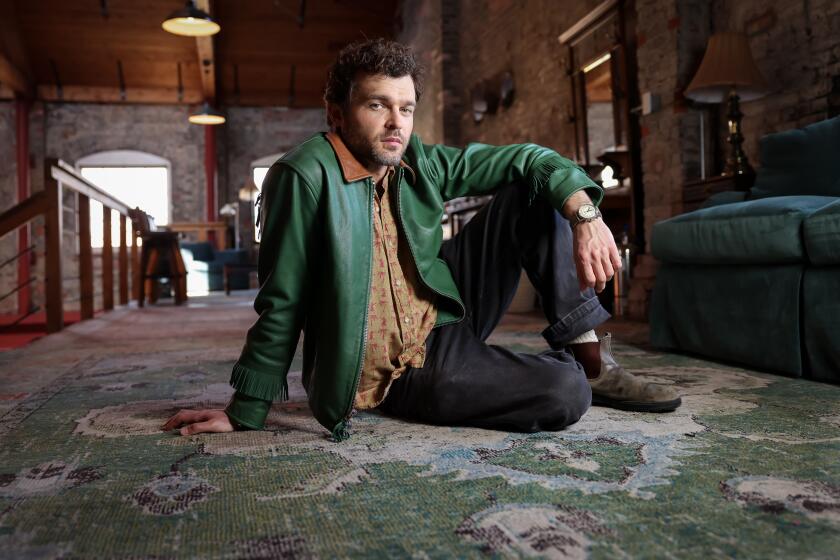This artist’s work crosses borders. So does her 25-year retrospective
- Share via
TIJUANA — Irma Sofía Poeter is an artist who has always had one foot on each side of the border. Her father was from the United States; her mother, from Mexico. She was born in Arcadia and grew up in Ensenada. For a time, she lived in San Diego and maintained her art studio in Mexico. So it made sense that when it came time for her to stage her 25-year retrospective, it would take place in both Mexico and the U.S.
This includes a survey of paintings, textiles and assemblage pieces at the Tijuana Cultural Center (known by its Spanish acronym, CECUT), on display through March, along with a small installation of her work at a community art space in San Ysidro called the Front, which will remain on view until late February.
Together, the shows mark the nature of journeys.
There’s the obvious act of getting from one gallery to the next, two spaces that lie 2.7 miles from each other, in contiguous territories that share culture and language but require a passport and patience to navigate. (My Tijuana taxi ran out of gas while attempting to locate an unclogged route to the border station.)
And there are Poeter’s own migrations — between nations but also within Mexico. Two years spent in Oaxaca, known for its rich artistic traditions, added a jolt of color and vibrancy to her work.
“Una y el otro: Devenir en relación” (“Herself and the Other: To Become in Relation”), as both shows are titled, also track the artist’s journey from painting to performance to textile art, the latter of which fuses elements of pop culture, artisanry and contemporary art into works that dwell on labor, identity and gender.
Certainly, it is the textile works that are most worth exploring. This includes various installations that employ fragments of clothing, an artifact that not only serves as a marker of personal taste but of the wearer’s social, economic and political class.
One piece at CECUT features a group of 32 blue men’s work shirts stitched together in a geometric pattern, a color-field installation that displays the literal origins of “blue collar.” Another, titled “Realidades desgastadas” (“Worn Realities”), from 2005, features a large undulating piece of parachute fabric suspended above the floor, from which dozens of men’s shirt sleeves loosely dangle — like disembodied arms reaching down toward the viewer.
“That was originally a site-specific piece for a hallway — you pass underneath and they touch you,” says independent curator Adriana Martinez, who organized the two-part exhibition in collaboration with curator Reyna Aguiar. “The sleeves evoke mass production, the production of the maquilas, the logic of work.”

At the Front in San Ysidro, Poeter re-creates her 1998 installation “Suspended Sentences,” which featured clothing once donned by a circle of female artists in Tijuana. Re-creating entirely out of white fabric, she has stuffed and stitched together their garments in a form that evokes a supernova — and suspended it over tidy arrangements of women’s shoes.
The piece takes the garments that can constrain women’s bodies and makes of them something just a little supernatural. It also serves as a curious record of the women who have helped shape the Tijuana art scene.
Also on display, at both CECUT and the Front, are textile works that are presented on stretcher bars, like paintings. These feature repeating or mirrored patterns that evoke the meditative qualities of Rorschach tests and mandalas. Instead of paint, however, Poeter uses lace, sequined appliqués and other common craft objects that she carefully stitches onto broad pieces of fabric.
A standout is the mandala-style piece titled “Eduardo,” from 2018, on view at CECUT, which takes its title from the name Poeter would have had if she had been born a boy (and a name she sometimes employs).
It consists of a circular arrangement of girls’ blue jeans layered with an ebullient array of floral appliqués, bits of fabric and images of the Virgin of Guadalupe rendered in sequins, the virgins’ faces obscured by bits of lace. It is a kaleidoscopic vision of artisanry and the feminine as filtered by popular culture. It is also one of a series of works influenced by her residency in Oaxaca.
The Los Angeles artist who outcools the skinny girls, Gabriela Ruiz delivers surreal DIY visions of herself in “Full of Tears” at the Vincent Price Art Museum.
The exhibition at CECUT — the larger and more comprehensive of the two shows — shows Poeter mixing materials in other ways too: embroidering paintings and collaging textiles, lace and appliqués onto photographs.
Also included are some important transitional works, from the mid-aughts, in which she began painstakingly stitching delicate patterns onto slides originally taken by her father. With these, she breathes new life into unremarkable landscapes and vacation imagery.
“She brings the signifiers of sewing as a low art — something that is not recognized as a high art — and elevates it into the language of contemporary art,” says Martinez. “And she brings this mad genius to it as well.”
She also brings a taste for experimentation.
As with all experiments, some are bound to fail. The early paintings show an artist struggling to find her voice. But find it she does — in the small threads that bind garments, and one nation to the next.
Irma Sofía Poeter: Una y el otro — Devenir en relación
More to Read
The biggest entertainment stories
Get our big stories about Hollywood, film, television, music, arts, culture and more right in your inbox as soon as they publish.
You may occasionally receive promotional content from the Los Angeles Times.












